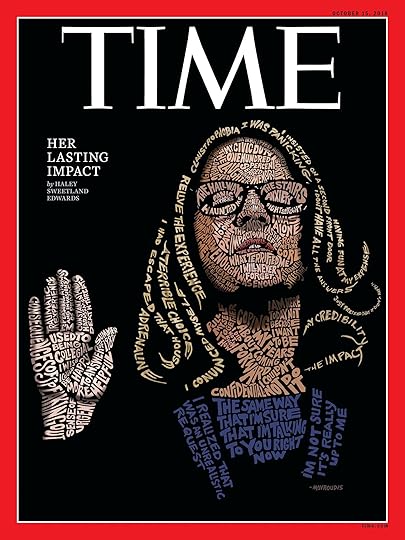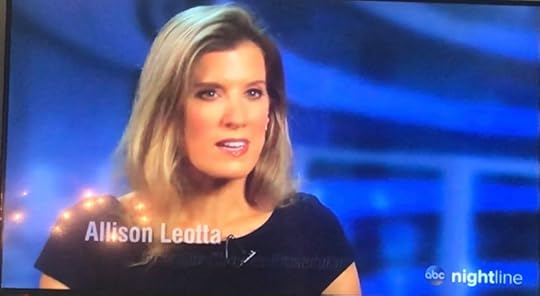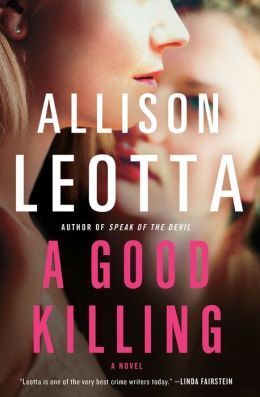Allison Leotta's Blog
October 15, 2018
The Myth of He-Said/She-Said
This essay originally appeared in TIME Magazine.
Americans have been told a dangerous myth. It is an old but enduring one, which gives its beneficiaries unwarranted power — and in many instances, is demonstrably false. The myth is that allegations of rape and sexual assault are often simply a matter of “he said, she said”; that when a woman accuses a man of a sexual assault and the man denies it, there is no way to discern the truth and the justice system is impotent. But so-called “he said, she said” cases can almost always reveal much more — if they are properly investigated.
Like many myths, the legend of “he said, she said” originated centuries ago. Under old English law, rape prosecutions could not be brought unless every material element of the victim’s story was corroborated by another witness or evidence. Because sexual assaults don’t usually happen in crowded pubs, this rule effectively barred many cases. Victims of any other type of crime — muggings, robberies, physical assaults — could provide the sole testimony at trial. Rape victims were uniquely excluded from the criminal justice system.
This exception was steeped in misogyny. The judges creating the law were all men; rape victims were overwhelmingly women. Women had lower status in that society, and rape claims were one of the few instances where a woman’s word might legally diminish a man’s authority. The institutionalized skepticism of female testimony was based on a medieval male fear of losing power.
The corroboration requirement lasted for hundreds of years and became law in the United States. It blocked the prosecution of most rapes. For example, a study in 1969 showed that New York City’s corroboration requirement resulted in eighteen rape convictions out of 1,085 arrests. An outcry in the 1960s and ‘70s caused many jurisdictions to reconsider their requirement, leading to some notorious debates. Arguing that New York’s requirement was necessary, famed midcentury jurist Morris Ploscowe reasoned that “ladies lie.” Nevertheless, New York abolished its requirement in 1972. Today, most jurisdictions have deleted their corroboration requirement.
But its spirit still lingers in the concept of “he said, she said.” This much is obvious, since the myth only comes up in sex crimes. You never hear about a “he said, she said” mugging case.
When Arizona prosecutor Rachel Mitchell wrote in a memo after questioning Dr. Christine Blasey Ford at the Brett Kavanaugh hearing that a “‘he said she said’ case is incredibly difficult to prove,” she neglected to mention that a sex-crimes prosecutor’s very job is to go beyond the parties’ contradictory statements to find evidence suggesting whether “he” or “she” is telling the truth.

Although corroboration is no longer a requirement in sex-assault prosecutions, it is valuable in every type of criminal case. Corroboration comes in many forms. Today, we use DNA whenever we can, but for a variety of reasons, survivors often delay reporting sex assaults (if they ever report at all, though, most never do) and DNA is often unavailable. So we look to less technical, but equally important evidence, such as eyewitnesses at the bar or party in question. We pull video surveillance, doctors’ reports, text messages, phone calls, social media posts, memoirs, calendars and yearbooks. Such evidence can substantiate — or refute — an alleged attack, even if no eyewitnesses saw the attack itself.
There may also be evidence that doesn’t directly prove what happened that day but may support or undermine the credibility of witnesses. We examine any motive to lie, such as divorce and custody proceedings, financial interests, romantic revenge or career prospects. We listen to testimony, noting when a witness is direct and helpful versus belligerent and evasive.
And we know that many sex offenders are recidivists. For example, according to a 2002 study, 90% of assaults on college campuses are committed by 6% of the males, with each assailant committing an average of five to six assaults. If a boy did it once, he probably did it again. So we search for additional victims of the same assailant.
What’s striking about the Kavanaugh case is that the evidence we saw at the hearing was more significant than what is presented in many criminal trials where a guilty verdict is returned. Dr. Ford’s credible testimony, her statements making this accusation years earlier, and her lack of motive to lie, especially compared to the incentives for her to stay silent, would be legally sufficient to sustain a criminal conviction for attempted rape. And that does not even consider the substantiating evidence provided by Kavanaugh’s friend Mark Judge’s autobiographical novel, Kavanaugh’s own crude yearbook statements and his evasiveness during questioning. If this were a mugging, we might just say “case closed.”
But the real shame about Mitchell terming this a “he said she said” case is that here, there are dozens of potential witnesses like Mark Judge who were not called to testify. Mitchell and the Senate Judiciary Committee took lawyers’ letters instead — hearsay statements that would never be allowed in Judge Kavanaugh’s courtroom or in any American trial, including one brought by Mitchell herself. Furthermore, under Federal Rule of Evidence 404(b), in a criminal trial, we would hear the testimony of the other two accusers in order to consider Kavanaugh’s intent, motive, and lack of mistake in his interactions with Ford. Hopefully the current FBI investigation will help remedy this. But if we are forced to endure the concept of “he said, she said,” we must at the very least look at the other two she’s.
At the core of the “he said, she said” myth is the idea that “ladies lie.” But studies show that rape claims are false at exactly the same rate as claims of any other crime, about 2–6% of the time. You’re just as likely to be falsely accused of mugging someone as raping them.
Either way, there are methods of discerning the truth in a court of law. We need to understand that when two people tell different stories — whether about a sex crime or an armed robbery — we can use common sense, reasoning and investigation to figure out what happened.
Meanwhile, we need to start treating sex crime victims’ testimony the same way as the victims of every other crime. And most importantly, we need to reject the myth, spawned 500 years ago in a medieval man’s world, that women cannot be trusted at their word.
Kavanaugh Hearing Coverage
I was asked to comment on the Brett Kavanaugh hearings by MSNBC’s Chris Hayes, Larry King, Nightline, and CNN’s Headline News. Follow the links or click below to see my take.


June 10, 2016
Beware the Adorable Rapist
Ladies, take a good look at a photo of Brock Turner. Doesn’t matter if you see the disheveled mugshot belatedly released by authorities or the smiling yearbook portrait offered by Turner’s parents. That’s the face of a rapist. Those big blue eyes, those perfect white teeth, that All-American smile. Don’t be fooled. That handsome swimming star raped an unconscious young woman behind a dumpster at Stanford University.
His six-month sentence didn’t reflect that – in part because Americans misunderstand the nature of rape.
We think of rapists as strangers lurking in bushes. We warn our daughters not to walk home alone late at night and instead to get a nice male friend to escort them. But that nice male friend, with his All-American smile and perfect teeth, is far more likely to rape you than anyone lurking in the shrubbery.
Our understanding of sexual assault has to change. We can’t save the lengthy jail sentences for “legitimate rapes,” as some politicians have called the boogeyman-in-the-bushes scenario. Acquaintance rape is real rape. It is the vast majority of sex crimes.
More than eighty percent of rapes are committed by an acquaintance. As a sex-crimes prosecutor, I handled hundreds of cases involving victims’ friends, fellow students, coaches, coworkers, religious leaders. My filing cabinets overflowed with rapes by the victim’s uncle, stepfather, or ex-boyfriend. Every year or so, we’d arrest a pedophile ice-cream man. Smiling acquaintances, all.
College cases, like the one featured in my latest novel, “The Last Good Girl,” often feature golden boys: football stars, frat guys, cute RAs. These rapists don’t use guns or knives. They use alcohol, the number one date rape drug in America. Kegs are their weapon.
And alcohol is usually their defense, too. But campus acquaintance rapes are not the misremembered drunken hookups that many people believe. In fact, 5% of college men commit 90% of the sex assaults on campuses. These assaults are not the result of intoxicated “miscommunications” but of serial predators who commit the same crime over and over. If a man has raped once, he likely did it before — and will do it again.
The survivor in the Stanford case aptly described Turner’s predatory conduct: “I was the wounded antelope of the herd, completely alone and vulnerable, physically unable to fend for myself, and he chose me.” Campus rapes often involve victims who are so intoxicated they cannot possibly consent; predators choose them for precisely this reason.
Deterrence is particularly important in these types of cases – but sentences don’t reflect that. Brock Turner’s sentence, six months out of a possible fourteen years, is not terribly unusual for this type of crime. The outrage over this particular case is the outrage that I felt over and over as a sex-crimes prosecutor, when my rape convictions in the local D.C. Superior Court routinely garnered fractions of the sentences given to federal drug defendants in the U.S. District Court, next door.
Why do we give mandatory jail sentences of decades to non-violent drug offenders, but fail to significantly incarcerate rapists like Brock Turner? Certainly, in Turner’s case, his blond hair and blue eyes played a role. I can’t imagine a black kid in the same situation getting the six-month slap on the wrist that Judge Aaron Persky gave Turner. Class, too, played a role. Turner comes from a background so privileged, the judge thought that jail time “would have a severe impact” on him (isn’t that what jail time is supposed to do?). Merely going through the process was punishment enough. White male privilege is alive and well.
But most of all, I think this is about our refusal to see acquaintance rape as a real crime. This attitude was reflected, unsurprisingly, by one of Turner’s friends in her letter of support for him. “This is completely different from a woman getting kidnapped and raped as she is walking to her car in a parking lot,” wrote Leslie Rasmussen. “That is a rapist. These are not rapists.”
Ms. Rasmussen, Judge Persky, America: Brock Turner’s case is what sexual assault looks like. This, or something like it, is happening to 20% of college women. The incredible, eloquent, gut-wrenching victim impact statement written by the survivor demonstrates what thousands of college women go through every year. We need to start taking this seriously.
We need to apply the laws on the books to acquaintance rapes, and actually give the jail time that is prescribed. We need to send a strong message to every young man who might walk an intoxicated young woman by a dumpster. Sex assault is not acceptable. It will be punished. Even when the assailant has a nice smile and impressive swim times.
This is rape. Let’s start treating it that way.
May 2, 2016
College Decisions & Campus Sex Assaults
The month of May is the deadline for many colleges’ tuition payment and the time when students must decide where to go. As a former sex-crimes prosecutor, I’m happy to see that many young women making this decision are checking the statistics about reported incidents of sexual assault on campus. But I’m afraid the statistics are misleading – sometimes deliberately so.
A college that reports zero sexual assaults is not safer than a college that does have reported incidents. Sexual assaults are happening at every campus. The college that reports zero sexual assaults is oblivious–or lying.
Here are the stark statistics. Ladies, you have a 20% chance of being sexually assaulted while you’re at school. One in five girls who go to college will be sexually assaulted before she leaves. The same is true for five percent of the boys. And yet for decades, many colleges have reported 0 rapes on their campus every year.
Mathematically, it doesn’t add up. In fact, many colleges have been sweeping these crimes under the rug for years to protect their reputations. No parent wants their daughter to go to Rape U. Applications go down when a college rape becomes public.
So, colleges have used various tactics to keep their assaults quiet. Some have discouraged reporting. They make the process difficult, hard to understand, drawn-out, clunky. Many survivors drop out because it’s so long and painful. If they make it through, many attackers have been found “not responsible,” the college equivalent of “not guilty.” Even in those cases where a rapist was ultimately found “responsible,” that number may not have made it into the annual report the college was supposed to make to the federal government.
Of course there are rules against these tactics. Title IX is a federal gender equity law that prohibits discrimination or a hostile environment based on gender. Courts have held that Title IX requires colleges to address sexual harassment among students — and the most extreme form of harassment is sexual assault. Similarly, the Clery Act is a federal law which requires universities to report the number of crimes on their campus every year.
But many colleges are under investigation for failing to comply with these laws. Currently, over 150 colleges are being investigated by the Department of Justice and/or Department or Education for violating Title IX and/or the Clery Act. These institutions range from some of the top universities in the country: Princeton, Harvard, University of Michigan, and University of Virginia, to giant state schools like Ohio State University, Indiana University, Iowa State, Oklahoma State, and Colorado University. The Chronicle of Higher Education keeps a running list here.
So what’s a student to do? How can you figure out the safety of the campuses you’re considering?
Of course, you should check the numbers the school itself publicizes. But be skeptical, understanding that zero rapes is almost impossible. Keep looking, keep asking questions. Obviously Google “your university + sexual assault” and read what comes up. Check out The White House Task Force to Protect Students from Sexual Assault, which has a state-by-state enforcement map showing investigations across America. The Department of Education has an online Campus Safety Tool – you can see how many reports they’ve received, campus by campus. The American Association of University Women’s “Ending Campus Sexual Assault Tool Kit” has great info, and more resources are on the site.
Finally, talk to girls on the campus – do they know anyone who’s been assaulted? How was she treated? Ask your student tour guide if they know what to do if they’ve been sexually assaulted.
Don’t be afraid to start this conversation. It’s so important to talk about this. Young women who are insisting on talking about this – like the authors of “We Believe You,” the extraordinary book by college sex assault survivors chronicling their experiences – are changing the national conversation, insisting that the world take this seriously. I’m trying to do the same with my latest novel, “The Last Good Girl.”

College can and should be a wonderful experience. There are steps you can take to reduce the chance of this terrible crime happening to you. But it also helps to go to a school that takes this problem seriously and is addressing it. That means a school that recognizes the problem exists.
Even at the best of schools.
March 24, 2016
THE LAST GOOD GIRL launch — and a free paperback!
I’m excited that my next book, THE LAST GOOD GIRL, is coming out on May 3rd! This is the fifth book in the Anna Curtis series (like the others, it can be read as a standalone). It’s about the disappearance of a college girl and the issue of campus sex assaults.

One of my favorite authors, Lisa Unger, said: “Every page of THE LAST GOOD GIRL crackles with authenticity and sizzles with suspense. Leotta knows her stuff and this is her best book yet.”
I hope you’ll like it too! And I hope you’ll pre-order it today.
As you might know, pre-orders are an author’s best friend. I want to thank and encourage everyone who pre-orders. So here’s the deal: Pre-order THE LAST GOOD GIRL by May 2, and I’ll send you a free Anna Curtis paperback of your choice.
Just shoot me an email at allison@allisonleotta.com with: (1) your receipt for purchasing THE LAST GOOD GIRL before May 2, 2016; (2) your mailing address; and (3) your choice of LAW OF ATTRACTION, DISCRETION or SPEAK OF THE DEVIL. The rest is on me!
Pre-Order Here:
Amazon
Apple iBooks
Barnes & Noble
IndieBound
Books-A-Million
Target
Thanks so much for your support!
Hope you’re having a wonderful spring and finding some great reads!
*The fine print: No P.O. boxes, please, and I can only mail to addresses within the United States. Your paperback will ship within two weeks (or sooner, depending largely on whether my kids actually go to sleep at bedtime).
September 24, 2015
Thanks for your support!
My latest book, A GOOD KILLING, got off to a great start because of you. Thanks so much for buying it, for telling friends, and for posting wonderful reviews! I’m very grateful to all my fantastic friends and readers.
OPRAH!
The critics were also kind. A GOOD KILLING was named one of “The Summer’s Best of The Best” by O, The Oprah Magazine!
THE WASHINGTON POST
The Washington Post also gave the whole series a nod, saying “[Leotta is] a writer exceptionally well-informed on crimes against women….These are smart, tough-minded tales, well worth a look.”
EVENTS
I’m thrilled to announce two terrific upcoming events. Come if you can!
Monday, October 5 at 6:30 pm
Busboys & Poets Takoma Park
“Women Crime Writers”
I’ll interview the fabulous Sarah Weinman, the foremost expert on American crime fiction. It should be a fascinating discussion. Free and open to the public.
Thursday, October 15 at 6:00 pm
Benefit for the Maryland Women’s Law Center
@ Goucher College, $100/ticket
For more info email ashley@marlazidelaw.com
GIVEAWAY
To thank you for your support, I’ll send you a signed copy of SPEAK OF THE DEVIL if you posted (or post in the next two weeks) an honest review of A GOOD KILLING on Amazon, Barnes & Noble, or Goodreads. Just shoot a link of your review and your mailing address to allison@allisonleotta.com and I’ll pop the book in the mail. Thanks!
Hope you’re having a great autumn, and enjoying back-to-school time (I am!) and this beautiful cool weather.
Happy reading!
June 5, 2015
How To Plan a Murder in Washington, D.C.
I had the honor of speaking at the Smithsonian last night, leading a seminar called “How to Plan a Murder in DC.” I didn’t actually teach any deadly moves, but talked about how DC serves as a great setting for thrilling stories in novels and TV. As part of the seminar, the audience helped plot a murder using people, places and motives that are uniquely DC. We took suggestions and voted – winners got copies of my books (of course). The winning plot – and their creators – are listed here:
Setting: The Library of Congress (Janice McLean)
Killer: The Director of the FBI (Charles Leven)
Victims: The Nationals Relief Pitcher (Charles Cowan) and the CIA Director (Cathy Wiley)
Method: With a baseball bat (Lisa King)
Motive: The pitcher is a spy, and the CIA director was covering it up (Jennifer Skidmore)
This was a mishmash of ideas, but all together, I actually think this could be a decent novel. 
Incidentally, Cathy Wiley, the woman who suggested the CIA director as a victim, was at the seminar with three other women… who were celebrating her bridal shower! I asked if Cathy’s husband-to-be knew that she was having her bachelorette party at a “How to Plan a Murder” seminar, and she said he wasn’t worried. At least she has an alibi for last night. Congratulations, Cathy, and thanks for making my seminar your last hurrah as a single lady.
While we’re plotting murders in DC, here are a few more suggestions, from friends who helped me brainstorm this on Facebook:
Tim Hepp: “With a fountain pen in the Politics & Prose fiction room.”
Ed Uthman: “Murder in the Ford Theater, then posing the body in the diorama in the Natural History Meusum, leaving the clue, ‘Sic semper Tyrannosaurus.'”
Professor Ross Emmett: “Federal sex crimes prosecutor found dead in the sand at the base of the Smithsonian’s Foucault pendulum.” (Yikes!)
“Someone takes out Boehner in his office, makes it look like over-tanning combined with lung cancer.”
“An associate’s office at any law firm downtown – they’ve been snuffing out people’s souls for years.”
And my favorite, from the brilliant thriller writer Patrick Lee:
“The Supreme Court justices are stealing the Hope Diamond from the National Museum of Natural History. A janitor catches them. They tie him up, then decide 5 to 4 to kill him.”
May 26, 2015
Read on…
Here are a few articles that I wrote recently for other sites. Readers of this blog might enjoy them, so I’m posting the links below.
I think we need to recalibrate our understanding of sexual assault: specifically, our understanding of who poses a danger to us and our kids. More often than not, it’s the devil you know. To find out why, read The Monster in the Three-Button Suit on Above the Law.
TV crime fans may appreciate the guest post I contributed to Joyce Lamb’s Happily Ever After column on USA Today: The Top 5 Things TV Crime Dramas Get Wrong.
And, of course, I’d love for you to stop by Simon & Schuster’s website and read the first chapter of my latest novel, A GOOD KILLING. Romance Reviews Today gave it their highest rating, a “Perfect 10.”
I hope you’ll like it, too!
May 10, 2015
Review A GOOD KILLING and get a chance to win a signed copy of all my books!
Hi folks! My newest book, A GOOD KILLING, launches on Tuesday! To celebrate, I’m doing a giveaway.
Leave an online review of A GOOD KILING, or tweet about it, and you could win a signed set of my books. I’m giving 5 sets away. Just post a review on Amazon, Barnes & Noble, or Goodreads. Then shoot me the link at allison@allisonleotta.com or sign up here: a Rafflecopter giveaway.
Good luck and thanks for your support! There’s no greater gift you can give an author than to spread the word about her book.
Review A GOOD KILLING and get a chance to win my first three books!
Hi folks! My newest book, A GOOD KILLING, launches on Tuesday! To celebrate, I’m doing a giveaway.
If you tweet about A GOOD KILLING or leave an honest review of it, you could win a signed set of my first three books. I’m giving 5 sets away. Click here to sign up: a Rafflecopter giveaway.
Good luck and thanks for your support! There’s no greater gift you can give an author than to spread the word about her book.




